#caldecott medal
Text
Milestone Monday
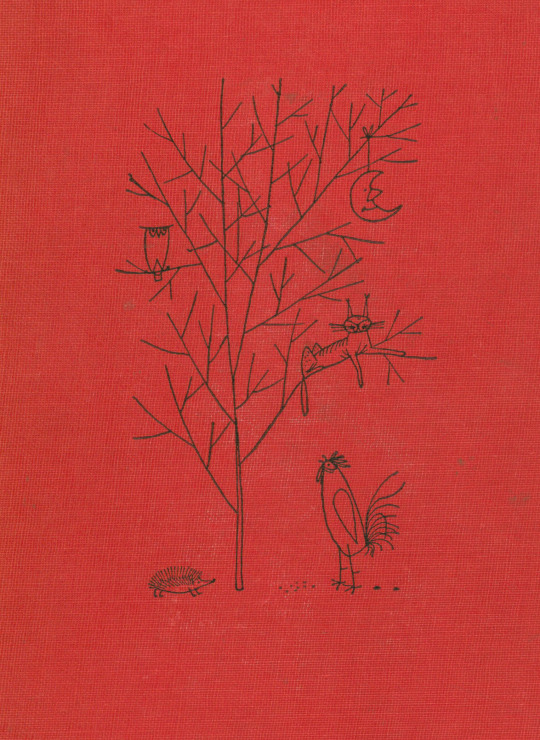

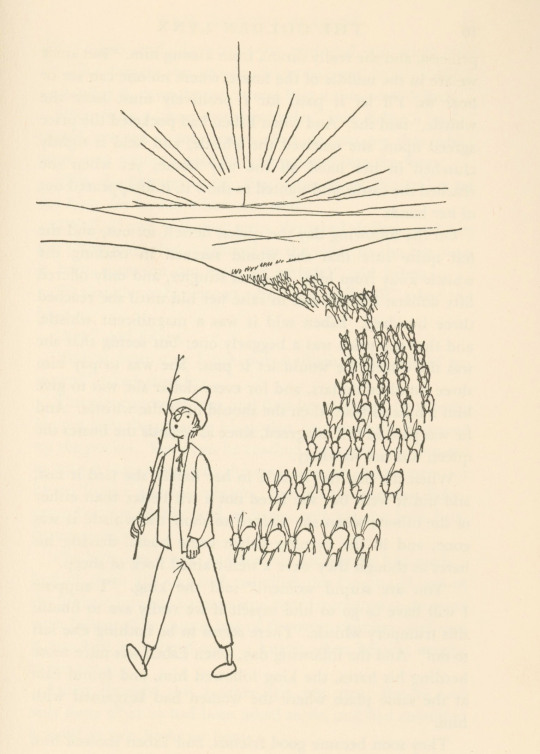
The King's Hares, from Norway

The Princess with the Twelve Pair of Golden Shoes, from Denmark

Queen Crane, from Sweden

The Rooster, the Hand Mill and the Swarm of Hornets, from Sweden

Ti-Tirit-Ti, from Italy

The Adventures of Bona and Nello, from Italy

The Hedgehog Who Became a Prince, from Poland
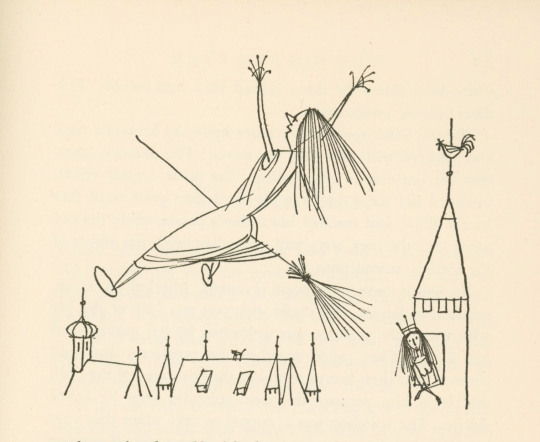
The Flight, from Poland
April 1st is the birthday of American librarian and storyteller Augusta Braxton Baker (1911-1998). Born to two schoolteachers in Baltimore, Baker was a voracious student who read at a young age and careened through elementary and high school. With advocacy support from Eleanor Roosevelt, Baker was admitted to the Albany Teacher’s College and in 1934 earned a B. A. in Education and a B. S. in Library Science making her the first African American to earn a librarianship degree from the college.
In 1939, Baker went on to work as the children’s librarian at New York Public Library’s Harlem branch, founding the James Weldon Johnson Memorial Collection of Children’s Books to showcase representation of Black children and life in books, and beginning a lifelong career with children’s literature and the New York Public Library (NYPL). In 1953, she was appointed Storytelling Specialist and Assistant Coordinator of Children’s Services, quickly moving into the Coordinator of Children’s Services position years later and becoming the first African American to hold an administrative position with NYPL. Throughout her career, Baker was active with the American Library Association, and chaired committees for the Newbery Medal and Caldecott Medal recognizing excellence in children’s literature.
In celebration of Baker’s birthday, we’re sharing The Golden Lynx and Other Tales, a collection of international folk tales compiled by Baker and illustrated by Austrian artist Johannes Troyer (1902-1969). This is the first edition of the book published in 1960 by J. B. Lippincott and is signed by Baker, who writes in the introduction, “No story has been included in this collection that has not stood the supreme test of the children’s interest and approval”.
Read other Milestone Monday posts here!
View more posts on children's books here.
– Jenna, Special Collections Graduate Intern
#Augusta Braxton Baker#Milestone Monday#The Golden Lynx and Other Tales#Johannes Troyer#J.B. Lippincott#New York Public Library#American Library Association#Newberry Medal#Caldecott Medal#Historical Curriculum Collection#birthdays
40 notes
·
View notes
Text
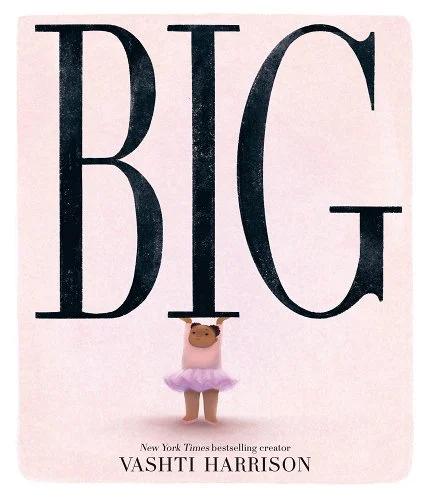

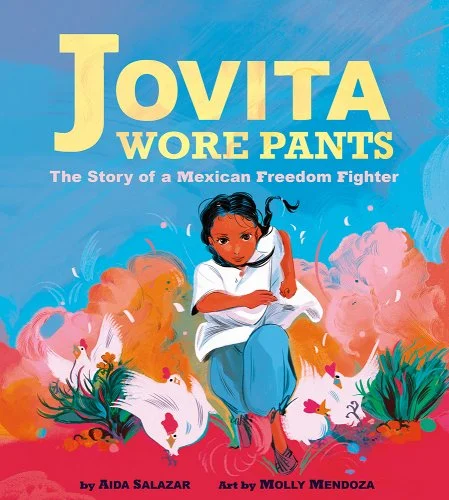


Congratulations to the 2024 Caldecott books!
#Big#Vashti Harrison#In Every Life#Marla Frazee#Jovita Wore Pants#Aida Salazar#Molly Mendoza#There Was a Party For Langston#Jason Reynolds#Jerome Pumphrey#Jarrett Pumphrey#The Truth About Dragons#Julie Leung#Hanna Cha#Caldecott Medal#ALA Youth Media Awards
32 notes
·
View notes
Text

Remember by Joy Harjo, illustrated by Michaela Goade
#illustration#art#book illustration#native american author#joy harjo#picture book#children's literature#native american illustrator#artist#illustrator#kids books#caldecott medal#indigenous kid lit#kid lit#sassafras and moonshine
12 notes
·
View notes
Text
2023 ALA Youth Media Awards
I was a little disappointed by the coverage of the Youth Media Awards. So few of the book jackets were featured in the articles I read. I'd like to say a special thank you to @the-dust-jacket for taking the time to put together the beautiful posts I have reblogged below.
The Newbery, the Caldecott, the Coretta Scott King, the Bel Pre etc etc-- the whole point of these awards is to drive sales. Because those sales motivate publishers to print more diverse books. The bigger the sales bump, the more important the prize; the more important the prize, the bigger the sales bump.
I think seeing the covers makes a huge impact and I hope @the-dust-jacket's posts gets lots of reblogs.
Congratulations to all those honored this year!
#youthmediaawards#newbery medal#caldecott medal#schneider family awards#michael l printz award#alex award#stonewall book award#sydney taylor book awards#Loretta scott kings book awards#pura bel pre awards#mildred l batch elder award
38 notes
·
View notes
Text

🏅 #1343
1 note
·
View note
Text

The Polar Express (2004, Robert Zemeckis)
06/12/2023
The Polar Express is a 2004 animated film directed by Robert Zemeckis.
The film is based on the screenplay by Zemeckis himself and William Broyles Jr., while the story is based on the illustration children's book of the same name by Chris Van Allsburg, published in 1985 and awarded with the Caldecott Medal the following year. Furthermore, it is the first cartoon made in CGI using the performance capture technique (i.e. with digital characters obtained by capturing the movements of real actors), which is why it became part of the Guinness Book of Records. This film is dedicated to Michael Jeter, a cast member who died during filming.
In addition to the version in standard 35 mm format, a version for IMAX technology was distributed using the same 3D models adopted in the standard version: Polar Express, specifically, was the first animated film not made for this type of technology be presented in this format.
A video game of the same name was distributed, in conjunction with the film, by Sony for the PlayStation 2 and by Nintendo for GameCube and Game Boy Advance; the game was developed by the Australian software company Blue Tongue Entertainment, and has some divergences from the story of the feature film.
The protagonist is a man originally from Grand Rapids, Michigan, whose name is never revealed, who shows in flashbacks an extraordinary adventure he lived as a boy.
During the night of Christmas Eve, the child goes to sleep strongly convinced that the gifts will be placed under the tree by his parents and not by Santa Claus, in whose existence he does not believe at all, unlike his parents and his younger sister Sarah. Just a few minutes before midnight, the boy, unable to sleep, hears a loud noise and sees a strong light coming from outside and realizes that a mysterious stream train has stopped on the road that runs alongside his house, which seems to have appeared out of nowhere, called the Polar Express; the conductor, a gruff but good-natured middle-aged man, explains to the young man that this train takes children to the North Pole, allowing them to meet Santa Claus.
#the polar express#animation#2004#robert zemeckis#screenplay#William Broyles Jr#Scriptment#chris van allsburg#1985#Caldecott Medal#Computer generated imagery#motion capture#guinness world records#michael jeter#35 mm movie film#imax#sony#playstation 2#nintendo#gamecube#game boy advance#australia#software#Grand Rapids Michigan#michigan#christmas eve#christmas tree#gift#santa claus#Midnight
1 note
·
View note
Text
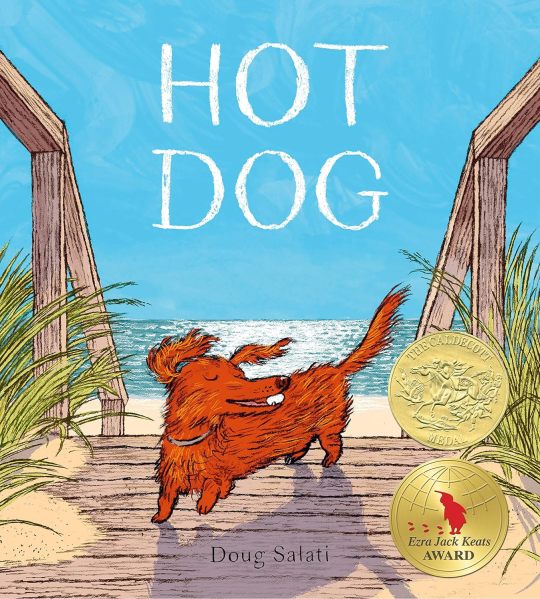
A colorful, charming picture book that depicts one beautiful day in the life of a dog from New York City. On a particularly sweltering day in the city, a pet dachshund has had enough of the heat, so his understanding owner takes him to the beach, where he can run to his heart’s delight and have small adventures of his own.
Genre: Picture Book (Caldecott Medal)
Target Age Group:
Ages 4-8
Justification:
I’ve seen Hot Dog many times this past autumn—on the Caldecott lists that parents give us to request all the books, copies coming in and out to fulfil holds from those parents, and even on my shelving cart a time or two when all the holds are miraculously filled. The cover art always charmed me; while I’m not familiar with Doug Salati’s name, I’ve seen his illustrations on many picture books, and his style has always made me smile. I jumped at the opportunity to take Hot Dog home as part of this project.
Evaluation:
For this review, I will be evaluating illustrations, mood, and style and language. Every illustration in this book is beautiful, expressive and fluid; on the first verso, the publisher notes that the images in the book were “created using a combination of pencil and gouache on paper and Photoshop.” The pencil lines are slightly sketchy, bringing real life and motion to drawn characters. While the majority of the illustrations are composed of pencil drawings with gouache to color in bright, solid blocks of color, several illustrations are primarily gouache and are truly paintings.
Salati sets the mood primarily with his choice of color, using a palette composed almost entirely of warm, saturated colors to illustrate the hot city—the page where the titular dog has had quite enough is made up of oranges, reds, and yellow, conveying the oppressive heat. In contrast, the beach to which he and his owner escape is rendered with a much more balanced color palette, where vivid greens and blues are tempered by pale pinkish sand and the orangey-red color of the dog himself (as well as his owner’s vivid red hair). It feels refreshing, clean, and balanced in a way the bright warm city doesn’t.
The language of Hot Dog is nothing short of poetry. Most pages have only one or two lines; at the beginning, when the narrator—the dog—is growing uncomfortable and upset in the heat, each line is short, conveying a brief spark of feeling with each line. Salati uses a few elemental writing techniques in the text, such as alliteration (“steamy sidewalks/concrete crumbles/sirens screech”, [Salati 2022, p. 1]), metaphor (“unfolding sky” [Salati, p. 14]), and personification (“sun sinks down, swallowed by the sea” [Salati, p. 26]), which, besides being very effective, may introduce already-literate children to techniques like this.
Frankly, I adored this book. I might just have been having a bad week, but the simple joy of a dog running on a beach made me tear up a little. Salati's illustrations make it clear how much the dog's owner loves him and how happy he is to be racing around on his own. While I definitely plan to have this for my children (once they're old enough to understand poetry a little), I might get a copy for myself just to look at.
References:
RH Childrens Books. (n.d.). Hot Dog by Doug Salati. PenguinRandomhouse.com. https://www.penguinrandomhouse.com/books/659445/hot-dog-by-doug-salati/
Salati, D. (2022). Hot Dog (D. Salati, Illus.). Alfred A. Knopf.
#hot dog#a: doug salati#i: doug salati#tag: children#g: picture book#g: fiction#caldecott medal winner#cm winner 2023
0 notes
Text


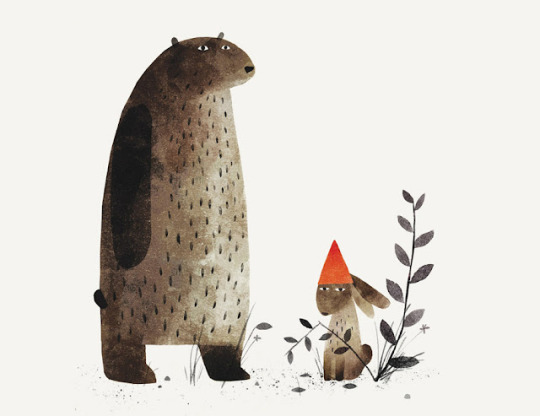
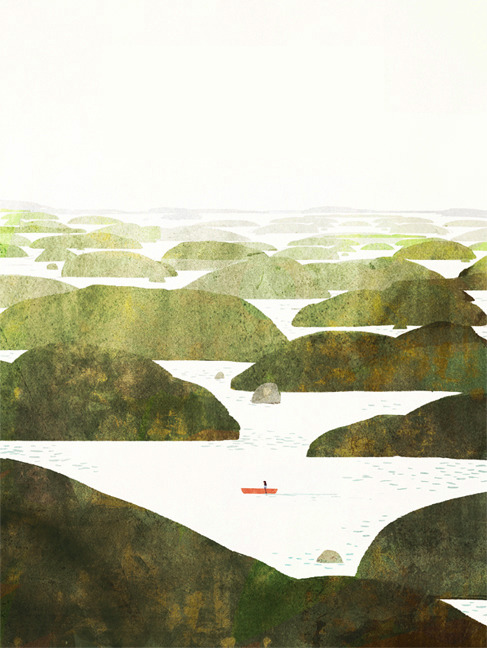



Jon Klassen CM (born 1981) is a Canadian writer and illustrator of children's books and an animator. He won both the American Caldecott Medal and the British Kate Greenaway Medal for children's book illustration, recognizing the 2012 picture book This Is Not My Hat, which he also wrote. He is the first person to win both awards for the same work.
27 notes
·
View notes
Text
#VoicesFromTheStacks
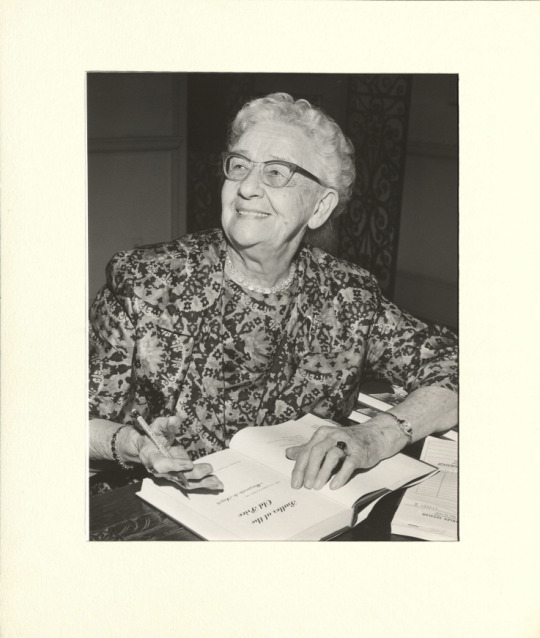
Marguerite de Angeli
Marguerite de Angeli (March 14, 1889) was an award-winning writer and illustrator of children’s books. Often inspired by her environment, many of Marguerite’s books have centered on stories from her family and childhood, and later from the lives of her children and grandchildren. These realistic scenes of families and children are what resonated most from de Angeli’s stories, with audiences finding her books to be absorbing and filled with eye-catching images.


Images: Left, Butter at the Old Price (1971) inscribed to the Wallace Family by de Angeli. Invitation to publication celebration laid in book. Right, mock up book cover illustration given to the Wallace family (James Wallace Papers)
Though born in Michigan, Marguerite’s family moved to Philadelphia when she was 13, which she later used as the setting for many of her stories. Although Marguerite was naturally skilled in writing and illustration, this did not become an active pursuit for her until later in life when her five children were nearly grown. Stemming from the Sunday school paper Marguerite illustrated in the 1920’s, de Angeli began to center her work on a younger audience, penning her first picture book in 1935. This book and the subsequent centered on two children, Ted and Nina, as they went to a grocery store and later played together on a rainy day. Inspired by two of her own children, Marguerite’s knack for recognizing beauty in everyday scenes would stick with her throughout the rest of her stories.


Images: Left, illustration from Bright April (1946). Right, Title page and inscription to Wallace family for Bright April.
While living in Pennsylvania, Marguerite came to know the Pennsylvania Dutch and Amish communities, incorporating their customs into her stories, as seen in her first Caldecott Honor Book, Yonie Wondernose (1944), the story of a curious Amish boy. She would later write about racial divisions in her story Bright April (1946), centered on racial prejudice in a post-World War II America. In 1950, Marguerite won her first Newbery Medal for the historical novel The Door in the Wall (1949), set in the Middle Ages as the Black Death sweeps across the country. She would later receive another Caldecott Honor and Newbery Honor for her Mother Goose adaptation and the Black Fox of Lorne, respectively. Though often centering on the stories of others, one of Marguerite’s last books, Butter at the Old Price (1971), tells the story of her family and the circumstances leading to her many stories and illustrations.



Images: Left, title page to The Door in the Wall (1949). Center, illustration from The Door in the Wall. Right, illustration and inscription to Antonia Wallace from The Door in the Wall.
We have most of Marguerite de Angeli’s works in our children's book collection, many of them inscribed to James M. and Christine K. Wallace and their children. James Wallace, relative to Henry A. Wallace, 33rd vice president of the United States, became friends with Marguerite and her family, as the two likely ran into each other at some point during their time in Philadelphia. Not only are many of the novels signed to the Wallace family by Marguerite, but a good few include Christmas cards and invitations to publication celebrations. Within the James M. Wallace papers, Christmas ornaments and illustrations made by Marguerite can be found as well as newspaper clippings and photographs of Marguerite, James and Christine.


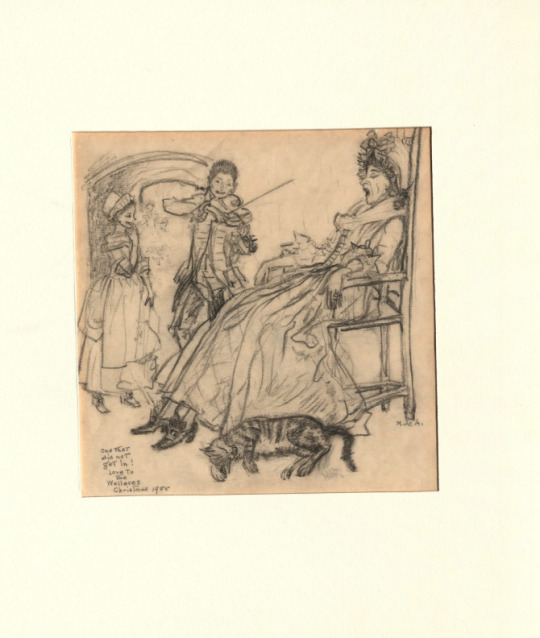
Images: Left, photo of Marguerite de Angeli, Christine and James Wallace. Center, Christmas card and ornaments made by de Angeli for Wallace family. Right, illustration that did not make it into a picture book given to Wallace family.
-- Kaylee S., Special Collections Olson Graduate Assistant
#uiowa#special collections#voicesfromthestacks#children's books#libraries#books of tumblr#Margeuerite de Angeli#women writers
30 notes
·
View notes
Text
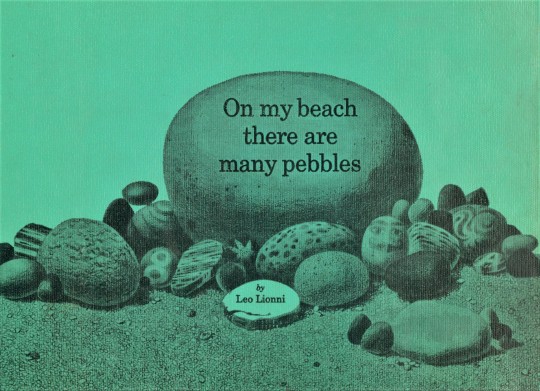
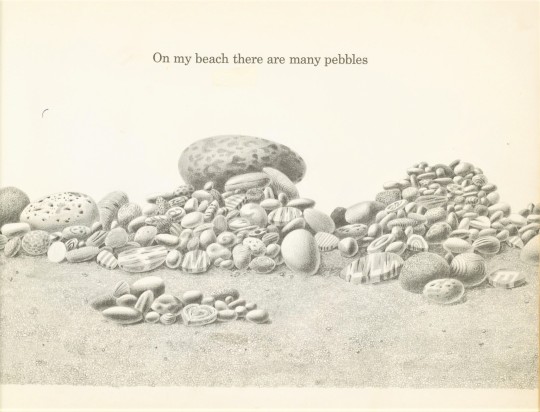


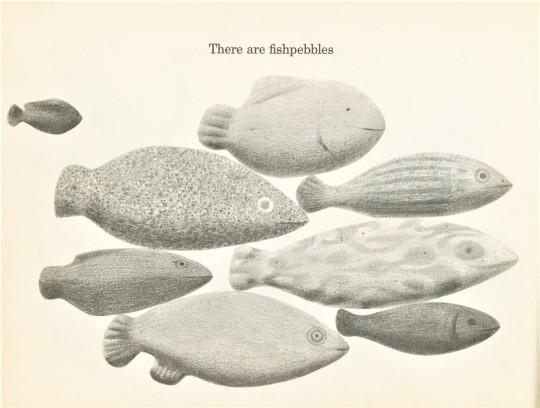



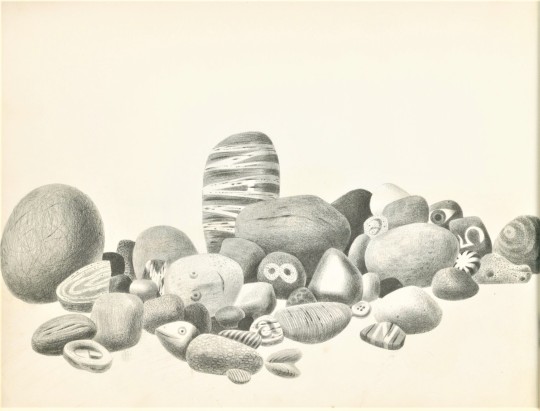

Staff Pick of the Week
My first Staff Pick of the Week is Leo Lionni’s whimsical children’s book On My Beach There Are Many Pebbles published in 1961 by Ivan Obolensky, Inc. In this book, Lionni (1910-1999) takes readers on a walk by an imaginative shoreline where he encounters a wide variety of anthropomorphized pebbles including fishpebbles, goosepebbles, and peoplepebbles to name a few. With brief text, readers are left to daydream over his intricate graphite illustrations of beach treasures.
Lionni was an Italian American who was well known for his accomplishments in painting and advertising designs. While living in Philadelphia in the 1940s he worked on advertising campaigns for Ford Motors and Chrysler Plymouth before accepting the arts director position at Fortune magazine.
Later in life, Lionni moved back to Italy and began his career as a children’s book author and illustrator. He produced over forty children’s books and received numerous awards for his efforts, including the Caldecott Medal on several separate occasions. He is also credited with being the first children’s book author/illustrator to use collage as the main medium for his illustrations. While On My Beach There Are Many Pebbles does not feature collage, one can certainly experience Lionni’s playful use of shapes and composition and appreciate his passion for simple storytelling.
View more children's books from our Historical Curriculum Collection.
View more Staff Picks.
-Jenna, Special Collections Graduate Intern
#staff pick of the week#leo lionni#on my beach there are many pebbles#Ivan Obolensky#Inc.#pebbles#illustration#children's books#illustrated books#Historical Curriculum Collection
163 notes
·
View notes
Text
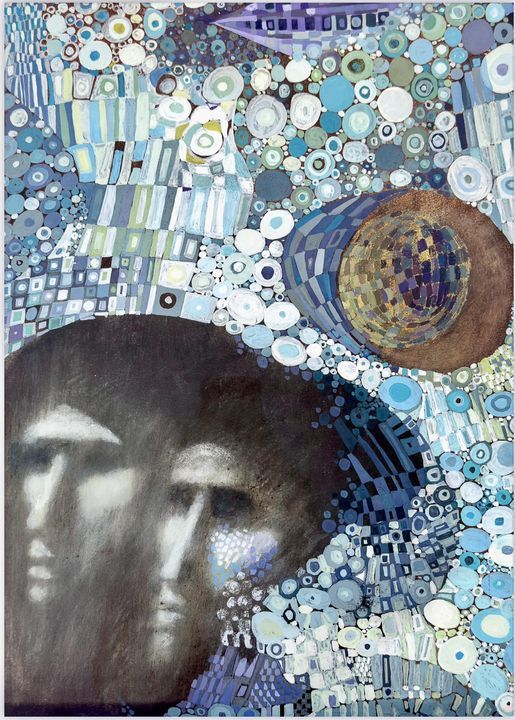
Original Cover Illustration Art
THE LEFT HAND OF DARKNESS
by URSULA K. LE GUIN
Dillon, Leo and Diane Dillon. Original cover illustration art for the first editionof Ursula Le Guin’s The Left Hand of Darkness.
Le Guin’s The Left Hand of Darkness was one of the first examinations of androgyny in science fiction. The ambisexual individuals on the planet of Gethen are a mirror of what an alternate Earth could be, and the novel explores the effect of sex and gender on culture and society.
Artists Leo and Diane Dillon won the Caldecott Medal in 1976 and 1977. Mr. Dillon was the first African-American to receive the medal. The Dillons’ artwork was influenced by African folk art, Japanese block printing, and medieval illumination.
[1969]. 609 by 483mm (24 by 19 inches). Illustration board. Image is 438 by 330 mm (17 ¼ by 13 inches). This is the original acrylic painted cover art by Leo & Diane Dillon, used by publisher Ace Books for its first edition of Ursula Le Guin’s novel The Left Hand of Darkness. Professionally framed with museum glass. Near Fine and in excellent condition.
Provenance: Ace Books gifted the artwork to Le Guin’s editor, Terry Carr, to commemorate the publication success of the book. Owned continuously by the Carr family, the artwork is now offered for sale on behalf of the Carr and Lichtman Estate.
$20,000
Contact: Mark funke, bookseller. [email protected] +1.206.632.1535
#ursula k. le guin#sci fi art#cover art#the left hand of darkness#leo and diane dillon#ace books#sci fi
9 notes
·
View notes
Text



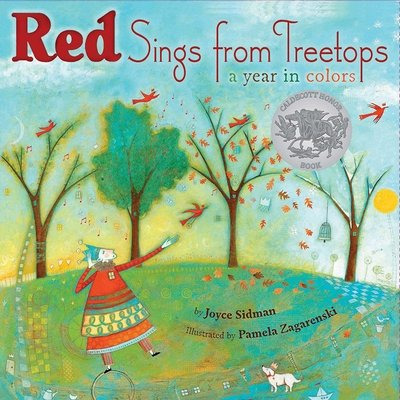
Pamela Zagarenski • Illustrations for poet Joyce Sidman's Red Sings From Treetops: A Year in Colors • Houghton Mifflin • 2009
#illustration#art#artwork#book illustration#caldecott medalist#children's literature#whimsical illustration#contemporary illustration#illustrator#sassafras and moonshine#pamela zagarenski#joyce sidman#randolph caldecott medal#award winning illustrator#kid lit#kid's book#kids' poetry
1 note
·
View note
Text

"Maurice Sendak" by Mariana R. Cook, 2005 (printed 2012). National Portrait Gallery, Smithsonian Institution. © Mariana R. Cook
* * * *
Maurice Sendak was part of my childhood. Sendak’s illustrations were seared into my brain, and I would have dreams that appeared designed by him.
Maurice Sendak wrote and illustrated "Where the Wild Things Are" in 1963, a highly original book—one that frightened a few teachers and Mrs. Sibley, our librarian—combining elements of the grotesque
with a largely upbeat story line.
As a child, Sendak grew up in a household scarred by the loss of family members to the Holocaust. He was a sickly boy who sought comfort in books and took pleasure in drawing from an early age.
He was awarded the coveted Caldecott Medal.
Sendak went on to produce other well-received children’s titles, including "Higglety Pigglety Pop! Or There Must Be More to Life" (1967) and "In the Night Kitchen" (1970).
In this portrait, Maurice Sendak poses with his dog, Herman.
[Follies Of God]
#Maurice Sendak#Follies of God#illustration#about art#Where the Wild Things Are#beloved#children's literature#gentle souls
18 notes
·
View notes
Photo





Congratulations to the 2023 Caldecott Medal winner and Honorees!
#Caldecott Award#Hot Dog#Berry Song#Ain't Burned All the Bright#Knight Owl#Choosing Brave#Doug Salati#Michaela Goade#Jason Reynolds#Jason Griffin#Christopher Denise#Angela Joy#Janelle Washington#awards
27 notes
·
View notes
Text
Book List
Pre-K through 6th Grade
• Graphic Novel – Snapdragon by Kat Leyh
• Bluebonnet – Roller Girl by Victoria Jamieson
• Texas 2×2 – Solitary Animals: Introverts of the Wild, illustrated by Dominique Ramsey, written by Joshua David Stein
• Coretta Scott King winner – The Talk, illustrated by Briana Mukodiri Uchendu, written by Alicia D. Williams
• Pura Belpre winner – They Call Me Güero: A Border Kid’s Poems by David Bowles
• Caldecott Medal book – We Are Water Protectors, illustrated by Michaela Goade, written by Carole Lindstrom
• Informational or Biography – Radiant Child: The Story of Young Artist Jean-Michel Basquiat by Javaka Steptoe
• Disability or Differences – I Am Not a Label: 34 Disabled Artists, Thinkers, Athletes and Activists from Past and Present by Cerrie Burnell
• Poetry or Novel in Verse – Brown Girl Dreaming by Jacqueline Woodson
• LGBTQ+ – Melissa by Alex Gino
7th through 12th Grade
• Printz winner or Printz Honor book – The Hate U Give by Angie Thomas
• Banned or Challenged book – All Boys Aren’t Blue by George M. Johnson
• LGBTQ+ – The Lesbiana’s Guide to Catholic School by Sonora Reyes
• Romance – Flip the Script by Lyla Lee
• Graphic Novel – Komi Can’t Communicate, Volume 1 by Tomohito Oda
7 notes
·
View notes
Text

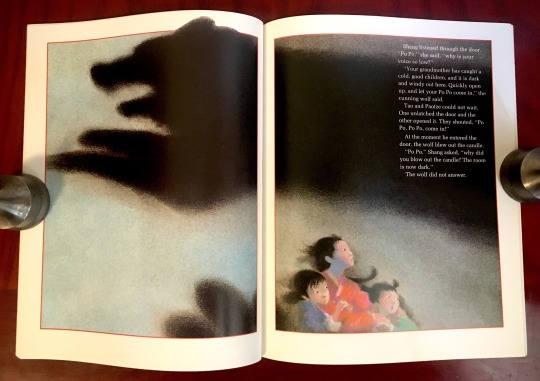


Book 284
Lon Po Po: A Red Riding Hood Story from China
Ed Young
Scholastic Inc. 1990
Chinese-born American illustrator and writer Ed Young has had an amazing career. The first book he illustrated was published in 1962, and since then Young has written or illustrated nearly 100 books and has won practically every award for achievement in children’s literature. Beautifully illustrated in dark watercolor and pastel washes, Lon Po Po won the 1990 Caldecott Medal.
#bookshelf#illustrated book#library#collection#personal library#personal collection#books#book lover#bibliophile#booklr#Lon po po#Ed young#scholastic#children’s books#folktales
15 notes
·
View notes